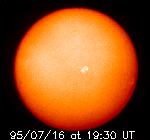The Sun

Introduction
- It was Galileo who first noticed that the Sun does spin. And that
was back in 1610!
- Let's see if you notice just as Galileo did that the Sun rotates.
- But you are going to be smarter than he was! He looked directly
at the Sun and even used his telescope to study it. We now know it is
DANGEROUS to look directly at the Sun, it can cause permanent eye
damage.
- There are some special filters you may be able to get from your
local planetarium, but do not use photographic negatives or Sun
glasses. They dim the bright light but do not shield out the harmful
rays that will permanently damage your eyes.
- Another option is to use a pin-hole box. If you want to make one
or learn more about the filters you may use to view the Sun, click here.
Internet Information
If you are ready to investigate Mr. Sol's rotation, you may click here for a list of dates for which images in H-alpha
or X-ray are available. Choose full disk images and select
several images that show some type of surface feature like a sunspot,
and then check images daily for a week or so.
We are curious if you will be able to tell the direction of
rotation and the time it takes for the Sun to make one complete
rotation.
Strategy
- Keep careful records of all Sun images you are going to work with.
- You can start with the image of the Sun on January 1, 1996. Notice the dark splotches?
- Those areas are sunspots, and although they are not permanent, they
last long enough for us to be able to follow them as they move with the
gaseous surface of the Sun.
- Notice and remember where these spots are.
- Click another date to get an image of the Sun a couple of days
later, on
January 6, 1996, for example. Did the spot move? (Since North is
up in these pictures, you should be able even to tell which direction
they moved.)
- Begin collecting data by:
- recording the date and time of the image you work with,
- using transparent plastic to trace the edge of the sun, and marking
the North pole which appears as a tiny white hatch mark at the top of
the image,
- marking the darkest part of a sunspot,
- comparing the locations of the sunspot on any two different
images,
- measuring the angle of rotation with the template.
- Calculate the angular velocity and the period of rotation of the
Sun by one of the methods we've discussed previously.
- You can also take a look at an animation (7.2Mb) showing the rotation of
the Sun
from January 1 through November 30, 1996. This movie has one image for
each day. As you can see this means that the speed of rotation
that you are seeing is not representative of reality, but you can
still calculate the period of rotation from this animation.
Questions
- If you pick a spot that is near the equator and figure out how
long it takes to make one trip around the sun, will spots near the
poles take more/less/the same amount of time?
- Are there always (from month to month or from year to year) about
the same number of sunspots on the sun? Or are there times when
sunspot activity is high (lots of spots and clusters of spots) and
other times when the activity is low (few spots and small clusters of
spots)?
- See if you can investigate to find answers to these questions, and
think of some more questions of your own. Find out as much as you can
about the sun. After all, it is the main source of energy for
EVERYTHING that goes on here on the Earth.
 Go
back to the "Student Area" Homepage
Go
back to the "Student Area" Homepage
 Go
to Vocabulary Page
Go
to Vocabulary Page
All text, images, and other resources in this
page are Copyright © 1995, The Regents of the University of California. All rights reserved.
For permission, email outreach@ssl.berkeley.edu.


 Go
back to the "Student Area" Homepage
Go
back to the "Student Area" Homepage